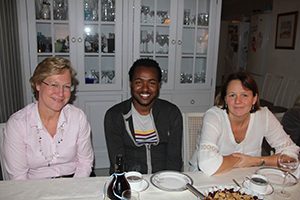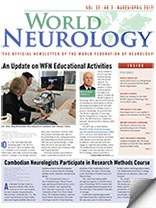Yohannes Debebe Gelan, MD
Neurologist and Assistant Professor at Addis Ababa University, Department of Neurology
Ethiopia.

Yohannes Debebe Gelan, MD, (center) together with the chairman of the Norwegian Brain Council and the chief physician at Oslo University Hospital during a social event.
I am Yohannes D. Gelan, a final-year neurology resident at Addis Ababa University, Ethiopia, at the time of the visit. I was very lucky to be selected to the prestigious WFN Department Visit program. I knew ahead of my visit that I would have a once-in-a-lifetime experience in Oslo. I visited the neurology units of Oslo University Hospitals (OUH) with a fellow African neurologist from Senegal named Marième Diop Sene.
My visit surpassed all my expectations. I was thrilled by the amount of attention and respect I received from the people I met in OUH. The visit took place from Oct. 21 to Nov. 18, 2016.
The first person I met in Oslo was Prof. Kari Anne Bjørnarå who took care of everything that I needed to survive the first few days in cold Oslo. On Saturday, Oct. 22, we toured the beautiful city of Oslo with Prof. Geir Slapø and his wife, Prof. Andrea Slapø. They were very welcoming. They took us to the Holmenkollbakken. I can’t imagine how people are brave enough to do skiing from that height. I rode on the zipline, which was fun.
We spent the first two weeks in Rikshospitalet, which is a highly specialized national referral center for Norway. We were introduced by Prof. Anne Hege Aamodt and Prof. Espen Dietrichs to all of the staffs of the OUH neurology department on the first day in their morning meeting. We were quite surprised that the method of communication was changed to English not only for the first days but also for most of the month we stayed with the department. The majority of the patients also were willing to speak to us in English. That helped to make my visit productive.
I was a little bit scared when we were asked to do a mandatory methicillin-resistant Staphylococcus aureus (MRSA) test before getting access to the wards. We were told that Norway has the lowest MRSA prevalence rate. Fortunately, the tests were negative, and we were given keys, IDs, and all the other things required to wander around the hospital.
A typical day in OUH starts with a morning meeting followed by radiology sessions. I was impressed by the level of communication between radiologists and neurologists. I have taken a lesson on the importance of working in tandem with radiologists for all neurologists. I hope we will start a similar system in our department as well. There were short presentations on Monday morning and Tuesday at lunch time.
The first week, I followed Prof. Aamodt in the vascular neurology and headache units. She was enthusiastic to show me everything despite her busy schedule at both the stroke and the headache units. I saw patients with rare causes of stroke. I observed how extracranial and transcranial Doppler ultrasound is useful in the evaluation of patients with acute stroke. Even though I wasn’t lucky enough to watch a thrombectomy being done, I saw how it may bring dramatic changes in a patient with vertebral artery thrombosis. I also witnessed occipital and supraorbital nerve blocks while Prof. Aamodt was working with her headache patients.
On the second week, I joined the movement disorder team. Prof. Inger Marie Skogseid showed us two cases of Wilson’s Disease and many more interesting cases. I was able to accompany her to the operating room when she was called to adjust the intraoperative deep brain stimulation (DBS) current setup for a patient with essential tremor. She also shared with us her vast experience on the use of DBS in dystonic patients. I also saw botulinium toxin injections for various movement disorders and chronic pain disorders. At the end of the second week, I visited the electrophysiology unit. Apart from the routine nerve conduction studies and EMG, I was able to observe quantitative sensory testing for the first time in my clinical experience.
During the third week, we went to Ullevål Hospital, which is the center for most of the neurological emergencies for the Oslo region. They also have a specialized center for multiple sclerosis. We were introduced by Prof. Sigrun Kierulf Braekken, the head of the neurology unit. The neurology staff in Ullevål hospital also made English their primary method of communication for us. The first days in Ullevål hospital were a bit difficult as the hospital architecture was so complicated, unlike the Rikshospitalet. I accompanied neurologists on the general neurology ward, and I observed the sophisticated care delivered at the center. It was interesting to see the long list of tests that are done from CSF samples. On the second day, I accompanied the neurologist in the emergency room. It was fascinating to see how the emergency multidisciplinary team works with such coherence and speed. The infrastructure and the equipment in the ER are quite astonishing. I had a chance to visit the stroke unit and neurology ICU.
I attended the neurological physical examination session on the third day of my stay in Ullevål hospital. It was good to see how the basics are done even in the high-tech setup. Finally, I joined the electrophysiology unit, and I got a great lesson in EEG interpretation from an electrophysiology fellow.
On the last week of my stay, I visited the Sunnaas Rehabilitation Hospital. The hospital is built on the hillside with an amazing view of the fjords. Prof. Frank Becker briefed me on the hospital. It is the highest rehabilitation center for Norway. It was interesting to hear about their experience with lifelong rehabilitation follow-up of some neurologic disorders. It is also a national center for locked-in-patients and rare neuromuscular disorders. I attended case discussions held between Prof. Tor Haugstad, the head of traumatic brain injury rehabilitation, and his colleague. Afterward, he showed me around the individual patients’ rooms, the gymnasium, the swimming pool, and the workshop for occupational rehabilitation. The meticulousness of their approach in rehabilitation of patients is something I should dream of establishing in my home country.
At last, I went to visit Spesialsykehuset for Epilepsy (SSE). Prof. Ellen Molteberg showed us around the adult and pediatric wards, epilepsy monitoring unit, the center for mentally handicapped children, and the special school for children and adolescents with epilepsy. I visited the kitchen for ketogenic diet preparation. I also was able to observe when ambulatory EEG is applied and the results are read. I learned a lot from morning discussions on peculiar EEGs on new admissions. We were really impressed by the clinical work as well as by the dedication for research activities in epilepsy. Prof. Cecilie Landmark showed us the sophisticated antiepileptic pharmacologic laboratory. She also briefed us about ongoing trials in their laboratory.
I believe this kind of visit to advanced neurological units is a source of inspiration for young neurologists like me from a developing country. I have acquired new clinical skills. I have gotten ideas on how to implement some of the things I observed in accordance with our available resources in Ethiopia. I would like to thank all members of the neurology department. I would like to thank Andrea and Geir Slapø. They are amazing people who made our weekends exciting. My special gratitude goes to Anne Hege Aamodt for inviting us to the Halloween and the neurology staff dinner party and for all of the support she provided during my entire stay. •
